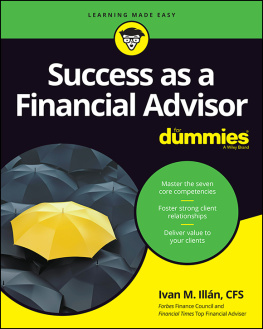Thank you for downloading this AMACOM eBook.
Sign up for our newsletter, AMACOM BookAlert , and
receive special offers, access to free samples, and
info on the latest new releases from AMACOM,
the book publishing division of
American Management Association.
To sign up, visit our website: www.amacombooks.org
To learn more about the American Management
Association visit: www.amanet.org

The Financial Advisors
Success Manual
How to Structure and Grow Your Financial Services Practice
David I. Leo, Founder
Street Smart Research Group LLC
Craig Cmiel, Co-Founder
Great Lakes & Atlantic Wealth Management & Advisory Partners LLC

This book is dedicated to my wife and family for all of the love they have given me regardless (of my faults).
David Leo
To my amazing wife, Joyce, who has been a great partner on this wonderful journey.
Craig Cmiel
Acknowledgments
I was proud and inspired to have received a wonderful mention from Mitch Anthony. Mitchs comments made me believe it was my responsibility not to lose what I have learned over a lifetime if it could be of value to others. This was my motivation for this book. A Forbes article that I read stated, But for all the good intentions, only a tiny fraction of us keep our resolutions; University of Scranton research suggests that just 8 percent of people achieve their New Years goals. I hope that many who read this book will find some ideas that can be of value to advisors, and to coaches of advisors, and ultimately to the clients of those advisors, and follow through by trying them.
David Leo
Contents
Executive Summary
Financial advisors must structure and organize their financial advisory practices so that they can put themselves in a position to grow their businesses. To structure and organize your business for efficiency and effectiveness, you need to:
Formally segment your book and analyze the results in depth. You may have already placed clients into A, B, and C service tiers. This segmentation should be reviewed and modified as needed annually. It should also be based on more than assets and/or revenues. Likability, willingness to heed your advice, and whether clients are a source of introductions and their future potential all impact their value to the business and therefore their tier.
Segmentation will also help you answer the question, How many clients can I effectively and efficiently manage?
Detail your Client Service Model or Promise for each of the client tiers you choose to service. In this book you will learn exactly how to approach detailing these promises using a structure that provides consistency and completeness for both the client and advisor.
Define and implement your six core client-facing processes:
Intake Processputting your best foot forward at the onset of your relationship
Financial Planning Processproviding a comprehensive set of wealth management solutions
Risk Management Processaccounting for lifes risk above and beyond investment risks
Investment Planning Processdelivered in a highly consultative manner
Client Service Processyielding a set of deliverables that is highly satisfactory to the client
Client Planning and Review Meeting Processdesigned to make your client communications highly effective and keep you and your clients aware of their satisfaction
Commit that every client you are willing to accept into your practice will receive a version of these processes based on their needs, the deliverables they deserve, their value to your business, and the fees you charge in compensation for the value you deliver.
Understand the value you deliver but also the cost of your deliverables. Value is determined by the client; cost is determined by you. Dont deliver items that clients dont value, because they almost always have a cost.
Develop a real business plan. This plan is much more than a set of goals. Goals are the What and the How Many. What do I want my 20XX assets under management (AUM) to be? What do I want my 20XX production to be? How many new clients do I want to acquire?
A business plan lays out the How, the When, and the Who. In addition to outlining where I am and where I want to be, the plan defines the strategies and tactics for how to get there, by when, and who has responsibility.
Develop a quantitative metrics plan. Quality actions lead to quality results. While you need to hit your numbers, its the action you take that will drive the numbers. This book addresses how to create an action plan and convert those actions to results.
Develop your marketing and sales approaches. Your business plan will call out the three to five marketing and sales approaches you plan to use as part of your client acquisition strategy. This book outlines the primary approaches available to you to acquire new clients and their assets. You need to detail which approaches you will use and how you will use them.
Develop your differentiation strategy. Before this can be done, you need to understand the processes you must implement and what ).
These are the elements you need to implement to have a successful financial advisory practice. With the exception of the marketing and sales approaches you will choose to implement as part of your client acquisition strategy, this is not a pick and choose menu of options but is much more like a surgical process. From the time a patient arrives at a hospital for his or her procedure until the patient leaves the hospital as a healthy individual, there are no optional steps. They are all required for an optimal outcome. I havent outlined all the other processes that a financial advisory team must execute (e.g., administrative processes, compliance requirements, continuing education requirements, and reporting). This book focuses on the processes and functions necessary for growing your business by bringing organization and structure to your practice.
Introduction
There is nothing more difficult to take in hand, more perilous to conduct, or more uncertain in its success, than to take the lead in the introduction of a new order of things. Niccolo Machiavelli
This book is designed for financial advisors (FAs) who want to grow their business by bringing organization and structure to their practices. We will discuss tools and techniques that can be used by advisors to service and expand their books of business. These tools and techniques are ones that have been used in coaching practice since 2001 to help advisors gather necessary data, interpret the meaning of findings, draw conclusions, and take the proper actions for improving client service and driving business growth. It is through continuing contact and holding FAs accountable for using the tools and implementing the processes that we bring about the benefits of a new model for doing business.
Coaching includes:
Discussing and explaining how each tool and technique applies to financial advisors and their practice
Interpreting the data and helping advisors actually apply the tools and techniques to improve their business
Holding advisors accountable for implementing the tools, techniques, and approaches
Each coaching engagement is specific to each FA and her or his book of business. Advisors must take on these roles themselves or with a partner, whether a coach or another advisor, who serves as an accountability partner. There are costs and benefits to both approaches.
Next page








